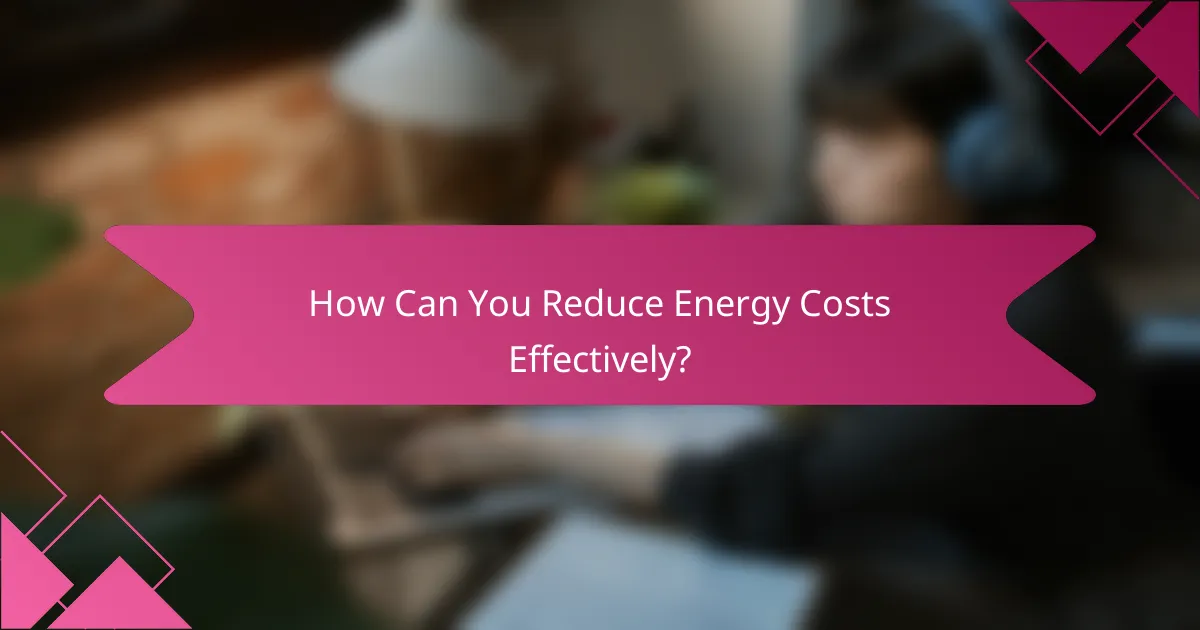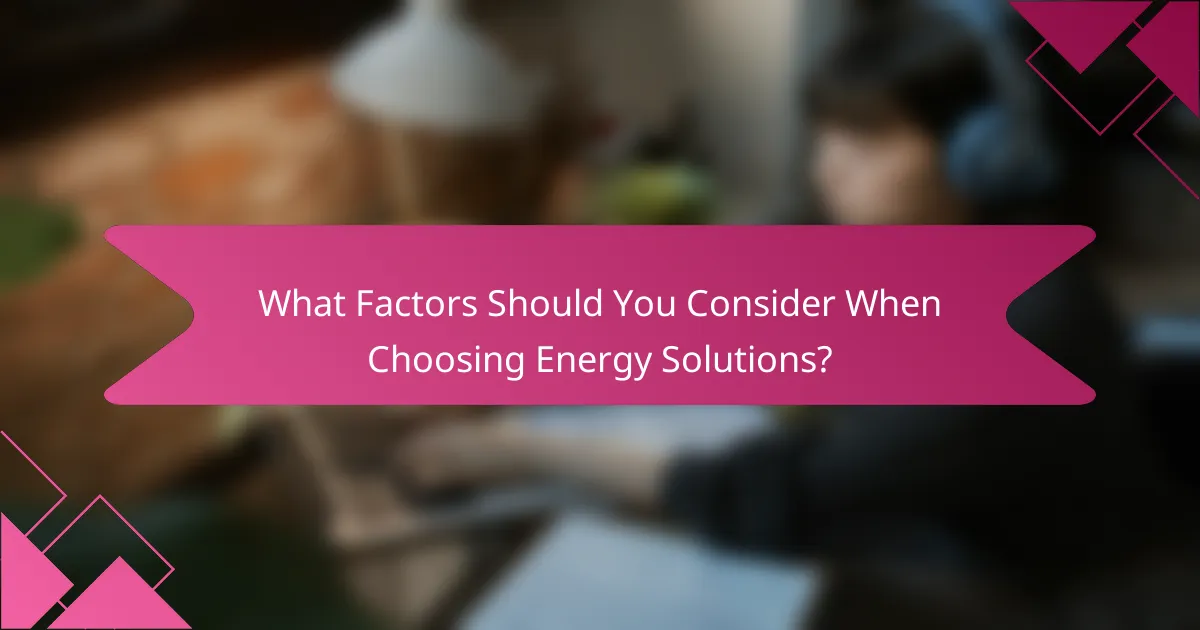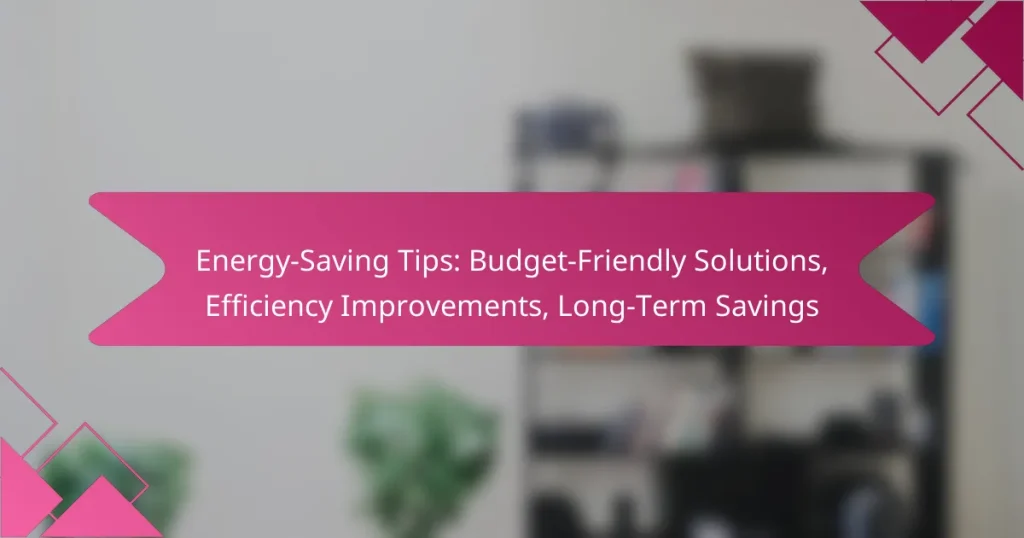Implementing energy-saving tips can lead to substantial long-term savings while improving the comfort of your home. By utilizing budget-friendly solutions such as smart thermostats, energy-efficient appliances, and proper insulation, you can significantly reduce your utility bills. These strategies not only enhance efficiency but also contribute to a positive environmental impact and increase your property’s value.

What Are the Best Energy-Saving Tips for Homes in the US?
To save energy and reduce costs in US homes, consider implementing smart thermostats, energy-efficient appliances, LED lighting, insulation improvements, and window treatments. These strategies can lead to significant savings on utility bills while enhancing overall comfort.
Smart Thermostats
Smart thermostats automatically adjust your home’s temperature based on your schedule and preferences, optimizing energy use. They can save homeowners around 10-15% on heating and cooling costs annually.
When selecting a smart thermostat, look for features like remote access, learning capabilities, and compatibility with your HVAC system. Popular models include the Nest Learning Thermostat and Ecobee SmartThermostat.
Energy-Efficient Appliances
Energy-efficient appliances use less electricity and water, helping to lower utility bills. Look for the ENERGY STAR label, which indicates compliance with strict efficiency guidelines set by the EPA.
Common energy-efficient appliances include refrigerators, washing machines, and dishwashers. Upgrading to these models can save households hundreds of dollars over their lifespan.
LED Lighting
LED lighting is significantly more energy-efficient than traditional incandescent bulbs, using up to 80% less energy. They also last much longer, reducing replacement costs and waste.
Switching to LED bulbs can lead to savings of $100 or more per year on electricity bills. Consider replacing high-use fixtures first, such as those in kitchens and living areas.
Insulation Improvements
Improving insulation in your home can prevent heat loss in winter and keep it cool in summer, leading to lower energy consumption. Focus on areas like attics, basements, and walls.
Consider using materials with high R-values, which measure thermal resistance. Adding insulation can reduce heating and cooling costs by 10-50%, depending on the existing insulation level.
Window Treatments
Effective window treatments can enhance energy efficiency by reducing heat gain in summer and heat loss in winter. Options include thermal curtains, shades, and window films.
Investing in quality window treatments can lead to energy savings of 10-25%. Look for products designed for energy efficiency, and consider combining treatments for maximum effect.

How Can You Reduce Energy Costs Effectively?
Reducing energy costs effectively involves a combination of strategies that enhance efficiency and lower consumption. By implementing practical solutions, you can achieve significant savings on your utility bills over time.
Conduct an Energy Audit
An energy audit is a comprehensive assessment of your home or business’s energy use. It identifies areas where energy is wasted and suggests improvements to enhance efficiency.
Consider hiring a professional auditor or using DIY tools available online. Common findings may include outdated appliances, poor insulation, or air leaks that can be fixed to reduce energy costs.
Use Energy Monitoring Tools
Energy monitoring tools help track and analyze your energy consumption in real-time. These devices can provide insights into which appliances use the most energy and when your usage peaks.
Smart meters and energy monitors can often connect to your smartphone, allowing you to adjust usage patterns based on data. For example, you might notice higher consumption during certain hours and shift usage to off-peak times to save money.
Implement Time-of-Use Pricing
Time-of-use pricing is a billing structure where electricity costs vary based on the time of day. By shifting your energy usage to off-peak hours, you can take advantage of lower rates.
Check with your local utility provider to see if they offer this pricing model. If available, consider running major appliances like dishwashers and washing machines during off-peak times to maximize savings.

What Are the Long-Term Benefits of Energy Efficiency?
Energy efficiency offers significant long-term benefits, including reduced costs and enhanced property value. By investing in energy-saving solutions, homeowners can enjoy lower utility bills, increased home value, and a positive environmental impact.
Lower Utility Bills
One of the most immediate benefits of energy efficiency is lower utility bills. By implementing energy-saving measures such as better insulation, energy-efficient appliances, and smart thermostats, homeowners can reduce their monthly expenses significantly. Many households can see savings of 20-30% on their energy bills over time.
To maximize savings, consider conducting an energy audit to identify areas for improvement. Simple actions like sealing drafts and upgrading to LED lighting can lead to substantial reductions in energy consumption.
Increased Home Value
Energy efficiency can boost your home’s market value. Properties equipped with energy-efficient features often attract higher offers and sell faster than those without. Buyers are increasingly looking for homes that promise lower operating costs and reduced environmental footprints.
Investing in energy-efficient upgrades, such as solar panels or high-efficiency HVAC systems, can yield a return on investment that ranges from 70% to over 100% depending on the local market conditions and energy prices.
Environmental Impact
Improving energy efficiency contributes to a lower carbon footprint, which is crucial for environmental sustainability. By using less energy, households can help reduce greenhouse gas emissions and decrease reliance on fossil fuels. This collective effort can lead to significant positive changes in local and global ecosystems.
To further enhance your environmental impact, consider adopting renewable energy sources, such as solar or wind power, alongside energy-efficient practices. This combination not only benefits the planet but can also provide additional savings in the long run.

Which Energy-Efficient Products Are Worth the Investment?
Investing in energy-efficient products can lead to significant savings on utility bills and reduce your environmental impact. Key products to consider include Energy Star certified items, high-efficiency HVAC systems, and solar panels, each offering unique benefits and savings potential.
Energy Star Certified Products
Energy Star certified products meet strict efficiency guidelines set by the U.S. Environmental Protection Agency. These products, which include appliances, lighting, and electronics, use less energy than standard models, helping you save on electricity costs.
When choosing Energy Star items, look for appliances like refrigerators, washing machines, and LED bulbs. These can reduce energy consumption by 10-50% compared to non-certified versions, leading to noticeable savings over time.
High-Efficiency HVAC Systems
High-efficiency HVAC systems are designed to use less energy while providing effective heating and cooling. Look for systems with a high Seasonal Energy Efficiency Ratio (SEER) rating, typically above 15, which indicates better performance and lower operating costs.
Investing in a high-efficiency system may have a higher upfront cost, but the long-term savings on energy bills can offset this. Regular maintenance and proper sizing of the system are crucial for maximizing efficiency and lifespan.
Solar Panels
Solar panels convert sunlight into electricity, providing a renewable energy source that can significantly lower your utility bills. The initial investment can be substantial, but many regions offer incentives, rebates, or financing options to help offset costs.
Consider the average installation cost of solar panels, which can range from $15,000 to $30,000 before incentives. With proper sunlight exposure, homeowners can often recoup their investment within 5-10 years through savings on energy bills and potential tax credits.

What Factors Should You Consider When Choosing Energy Solutions?
When selecting energy solutions, consider initial costs, potential long-term savings, and any local incentives available. Evaluating installation requirements and the efficiency of different options can also significantly impact your decision.
Initial Cost vs. Long-Term Savings
Initial costs refer to the upfront expenses associated with purchasing and installing energy solutions, while long-term savings encompass the financial benefits over time, such as reduced utility bills. It’s essential to balance these factors; sometimes, higher initial investments lead to greater savings in the long run.
For example, energy-efficient appliances may cost more upfront but can save you hundreds of dollars annually in energy bills. Aim for solutions that offer a payback period of five years or less to ensure a favorable return on investment.
Local Incentives and Rebates
Many regions offer incentives and rebates to encourage the adoption of energy-efficient solutions. These can significantly lower your initial costs, making it more affordable to switch to greener options.
Check with local utility companies or government websites for available programs. In the U.S., for instance, federal tax credits can cover a percentage of the cost for solar panels, while some states provide rebates for energy-efficient appliances.
Installation Requirements
Installation requirements can vary widely based on the type of energy solution you choose. Some solutions may require professional installation, while others can be DIY projects. Understanding these requirements is crucial to avoid unexpected costs or complications.
For instance, solar panel installations often need permits and professional expertise, while LED bulb replacements are straightforward and can be done independently. Always factor in these requirements when budgeting for your energy solution.

How Do Seasonal Changes Affect Energy Consumption?
Seasonal changes significantly impact energy consumption due to variations in temperature, daylight hours, and weather conditions. During colder months, heating demands increase, while warmer months often see a rise in cooling needs, leading to fluctuating energy usage throughout the year.
Heating Costs in Winter
In winter, heating costs typically rise as homes require more energy to maintain comfortable temperatures. The type of heating system used—whether electric, gas, or oil—can influence overall expenses. Homeowners should consider using programmable thermostats to optimize heating schedules and reduce unnecessary energy use.
Insulation plays a crucial role in winter energy efficiency. Properly insulating walls, attics, and basements can significantly lower heating bills, potentially saving 10-20% on energy costs. Regular maintenance of heating systems is also essential to ensure they operate efficiently.
Cooling Costs in Summer
Summer months often lead to increased cooling costs as air conditioning units work harder to keep homes comfortable. Energy-efficient cooling systems can help mitigate these costs. Homeowners should look for units with high SEER ratings, which indicate better energy efficiency.
Using fans strategically and closing blinds during peak sunlight hours can reduce reliance on air conditioning. Simple measures, such as setting the thermostat a few degrees higher, can lead to savings of 3-5% on cooling costs for each degree raised.
Impact of Daylight Hours
Longer daylight hours in spring and summer can decrease reliance on artificial lighting, thereby reducing energy consumption. Utilizing natural light effectively can lead to noticeable savings on electricity bills. Homeowners should consider adjusting their daily routines to take advantage of daylight.
In contrast, shorter days in fall and winter may require more artificial lighting, increasing energy use. Installing energy-efficient LED bulbs can help minimize this impact, as they consume significantly less energy than traditional incandescent bulbs.
Weather Variability and Energy Use
Unpredictable weather patterns can lead to spikes in energy consumption. For instance, an unexpected cold snap may increase heating demands, while a heatwave can drive up cooling needs. Homeowners should be prepared for these fluctuations by monitoring forecasts and adjusting energy use accordingly.
Investing in smart home technology can help manage energy consumption more effectively. Smart thermostats and energy monitors provide real-time data, allowing users to make informed decisions about their energy use based on current weather conditions.


